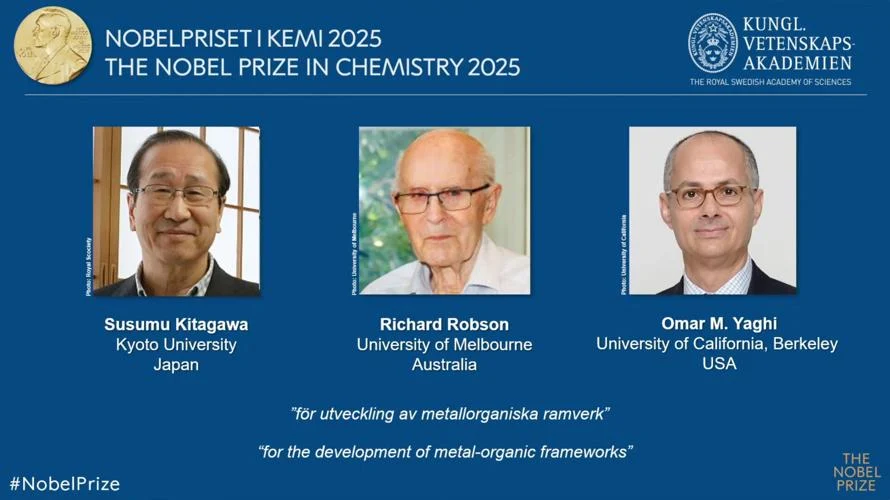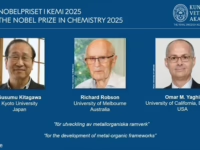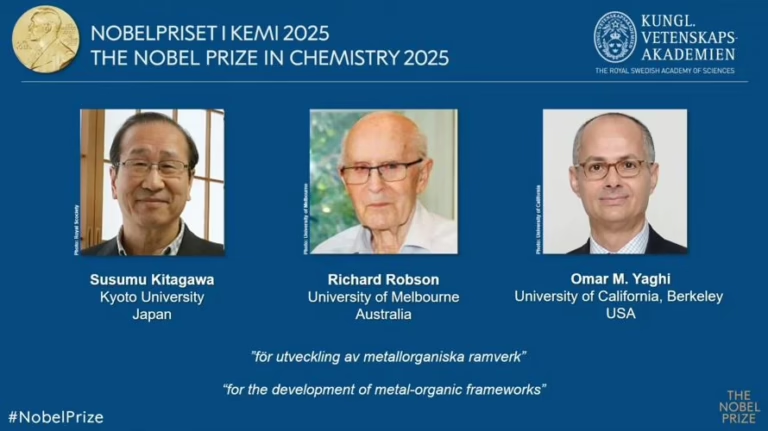The 2025 Nobel Prize in Chemistry has been jointly awarded to three pioneering scientists for their innovative work on Metal-Organic Frameworks (MOFs), a transformative advancement in molecular design. The Nobel Committee drew a parallel between these materials and Hermione Granger’s seemingly bottomless handbag from the Harry Potter series, highlighting their extraordinary capacity to contain vast internal spaces within minuscule structures.
Susumu Kitagawa, Richard Robson, and Omar Yaghi were honored for their trailblazing contributions, announced recently in Stockholm, Sweden. Their discoveries have paved the way for novel materials with promising applications in addressing critical global challenges such as environmental sustainability and climate mitigation.
Heiner Linke, chair of the Nobel chemistry committee, emphasized the importance of MOFs by explaining that these materials can “store enormous quantities of gases within a remarkably small volume.” He likened the structures to a bustling hotel, where numerous molecules act as guests, freely moving in and out of the material’s intricate cavities.

The committee highlighted the remarkable adaptability of MOFs, noting their ability to “extract water from arid air, trap carbon dioxide, sequester hazardous gases, and catalyze chemical transformations.”
Richard Robson, affiliated with the University of Melbourne, Australia, initiated this line of research in the 1970s. He proposed that connecting diverse molecules, rather than just individual atoms, could yield entirely new classes of materials. By the 1980s, Robson demonstrated that these compounds self-organized into crystalline frameworks resembling diamonds but featuring expansive internal voids instead of dense packing.
Building upon Robson’s foundation, Susumu Kitagawa of Kyoto University, Japan, sought to uncover practical uses for seemingly “impractical” materials. In 1992, he introduced his first porous molecular framework, and by 1997, he had developed a molecule capable of selectively absorbing and releasing gases such as methane, nitrogen, and oxygen.
Omar Yaghi, originally from Jordan and now at the University of California, Berkeley, advanced this research by creating MOF-5, a landmark framework recognized by the Nobel Committee as a “classic” in the field. This structure is exceptionally robust, maintaining stability even when heated to 570°F (300°C).
Professor Kim Jelfs remarked on the astonishing scale of MOFs’ internal surface area, stating, “A single gram of MOF material can possess an internal surface area equivalent to that of a soccer field.”
The laureates’ research has led to numerous practical applications. For instance, MOFs offer promising solutions to climate change by capturing atmospheric carbon dioxide. Additionally, Yaghi’s team demonstrated the ability of MOFs to extract water from desert air in Arizona, where the material absorbs moisture overnight and releases it when warmed by sunlight.
Beyond water harvesting and carbon capture, MOFs hold potential for environmental remediation, such as removing persistent “forever chemicals” from water supplies and breaking down pharmaceutical residues contaminating ecosystems.
The Nobel Prize includes a monetary award of 11 million Swedish kronor, roughly equivalent to $1 million.























0 Comments